 Cherai Beach: One of the most beautiful stretches of lovely golden beaches of soft sand facing the Arabian sea , an azure sky and warm clear sea, gives a perfect ambience tempting you to take a dip, go on indulge yourself and let the waves sweep you off your body and spend your time lazing on the beach and relax in the breeze shade undisturbed for some time, quench your thirst from tender coconuts and encounter with many a friendly crabs. Cherai Beach: One of the most beautiful stretches of lovely golden beaches of soft sand facing the Arabian sea , an azure sky and warm clear sea, gives a perfect ambience tempting you to take a dip, go on indulge yourself and let the waves sweep you off your body and spend your time lazing on the beach and relax in the breeze shade undisturbed for some time, quench your thirst from tender coconuts and encounter with many a friendly crabs.
The sun set providing the classic back drop is simply marvelous, for photo hunters to take a quick shot cut cruising into the sea ,if luck you could sigh the dolphin at play .few would disagree that nothing can compare with glorious landscape of cherai.
Back Waters: Backwaters of Cherai welcomes you with unique charm and beauty. A quiet trip through the winding scenic backwaters where the heart of Cherai leaves. The overhanging branches of coconut trees create an unforgettable symphony of green.
Lake: Tranquil Lake is at a stone throw from the beach. A unique place where sea and backwaters divided by a small strip of land for some zealous, true scenery is only found after watching the dawn breaks over the palms
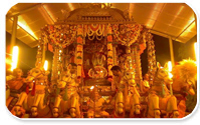 ASVD Temple & Chariot festival: Exquisite temple was constructed in A.D1869. Azheekkal Sree Varaha Venkateswara Temple is the only "Sampoornakshetra" in South India . This is the only temple in India where both the deities of Sree Varaha and Sree Venkateswara installed side by side and worshiped as single moorthy (God). ASVD Temple & Chariot festival: Exquisite temple was constructed in A.D1869. Azheekkal Sree Varaha Venkateswara Temple is the only "Sampoornakshetra" in South India . This is the only temple in India where both the deities of Sree Varaha and Sree Venkateswara installed side by side and worshiped as single moorthy (God).
The famous temple "Ratha" (Chariot) is a rarity in temple architecture. This is the only chariot in the world, which runs on the rail. The festival took place twice in a year. The chariot is pulled by devotees around the temple with huge drum beats.
Gowreeswara Temple: Important pilgrimage centre in Kerala also known as South Pazhani , built in 1912. Gowreeswara temple is dedicated to Lord Muruka. The idle was installed by Sree Narayana Guru. To see Cherai at her best come with the festival. The trumpeting of more than 30 elephants and the magical sound of "Panchavaadya" and the spectacular view of celebratory fireworks.
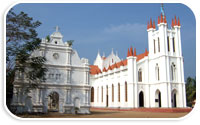 Pallipuram Church: The church is built by the Portuguese in 1577. The exquisite picture of Ave Mary on the top of "Altar" is brought from Portugal . Cherai's cultural life would be incomplete with out it festivals. The Church, which survived the Dutch on Catholic. And the amazing thing is that the Dutch even built a chapel for this church. Pallipuram Church: The church is built by the Portuguese in 1577. The exquisite picture of Ave Mary on the top of "Altar" is brought from Portugal . Cherai's cultural life would be incomplete with out it festivals. The Church, which survived the Dutch on Catholic. And the amazing thing is that the Dutch even built a chapel for this church.
Juma Masjid: An elegant mosque of harmonious proportions and simplicity. In 1869 the mosque was renovated, but there is no evidence when this was built.
Portuguese Fort: Built in1503 by the Portuguese also known as 'Aya Kotta'. It is the oldest European monument in India . It was an out post to safegaurd the famous Mussiris Port. In 1661 the Dutch captured the fort and in 1789 the fort was handover to the King of Thiruvathankoor. In 1795 it came under the British. The hexagonal fort is the best-preserved Portuguese bastion.
Paddy field: With green emerald paddy field attracts lots of tourists. Delightfully temperate rice producing centre of Cherai. And its pastoral surroundings are really charming.
Sahoodhara Bhavan: In 1889 july 22 Sahoodharan Ayappan was born ,he was the deciple of sree narayana guru in 1917 may 29 he gave a feast to so called lover castes he was a greate social reformer,journalist,his house which is situated on the banks of periyar river was open to the public .
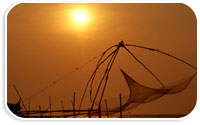 Kochi ( Cochin ): The eventful history of this city began when a major flood in AD 1341 threw open the estuary at Kochi, till then a land locked region, turning it into one of the finest natural harbours in the world. Cochin is the oldest European settlement in India,recording a history of visitors who came, saw and stayed for hundreds of years. Layered impressions - Chinese, Arab, Jewish, British, French and Portuguese, are contained within its environment. Kochi ( Cochin ): The eventful history of this city began when a major flood in AD 1341 threw open the estuary at Kochi, till then a land locked region, turning it into one of the finest natural harbours in the world. Cochin is the oldest European settlement in India,recording a history of visitors who came, saw and stayed for hundreds of years. Layered impressions - Chinese, Arab, Jewish, British, French and Portuguese, are contained within its environment.
The commercial capital of Kerala and the most cosmopolitan of the state's cities,Cochin has long been eulogised in tourist literature as the “ Queen of the Arabian Sea” with ferry rides commanding its breathtaking view.
Cruise around man-made islands with lush green lawns sloping down to the water's edge. Giant Chinese fishing nets that billow from massive teak and bamboo poles dot the entrance to the harbour. Silhouetted against the setting sun, they present a magnificent sight at the waterfront.Kochi is the arguably the ideal starting point for exploring the unfathomable diversity and beauty of Kerala, rated in the top three tourist destinations by the World Travel & Tourism Council and featured in National Geographic Traveler's '50 greatest places of a lifetime'.
 Jewish Synagogue: The synagogue, built in 1568, is magnificently decorated by Chinese tiles and Belgian chandeliers. Giant scrolls of the Old Testament can be found here. It is located near the Dutch Palace. Built in A D 1568. Great scrolls of the Old Testament (Bible) and copper plates in which the grants of privilege to Jews from Cochin rulers were carved are preserved here. Jewish Synagogue: The synagogue, built in 1568, is magnificently decorated by Chinese tiles and Belgian chandeliers. Giant scrolls of the Old Testament can be found here. It is located near the Dutch Palace. Built in A D 1568. Great scrolls of the Old Testament (Bible) and copper plates in which the grants of privilege to Jews from Cochin rulers were carved are preserved here.
St. Francis Church: It is the oldest church built by Europeans in India. On his 3rd visit to Kerala, Vasco De Gama, the legendary navigator from Lisbon, died at Kochi during his second voyage to Kerala. He was laid to rest in the St. Francis Church on Christmas eve 1524. Years later, his mortal remains were taken back to Portugal. The sepulcher is still preserved in the church hall and is open for visitors.
Vasco House: Believed to have been the residence of Vasco da Gamma, this is one of the oldest Portuguese residence of Fort Cochin. Built in the early 16th century Vasco House sports the typical European glass paned windows and Balcony cum Verandas characteristic of the times.
The Dutch Cemetery: The tomb stones here are the most authentic record of the hundreds of Europeans who left their homeland on a mission to expand their colonial empires and changed the course of history of this land. The cemetery was consecrated in 1724 and is today managed by the Church of South India.
Santa Cruz Basilica: The original church, situated in Fort Kochi, was built by the Portuguese in 1505 and named as a cathedral in 1558. The British colonists destroyed the cathedral in 1795. The current structure was built in 1905 and raised to the status of a basilica by Pope John Paul II in 1984.
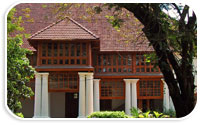 Bolghatty Palace: Built by the Dutch in 1744, this palace is on an island, off Cochin in the Arabian Sea. Earlier Dutch and later British used the palace as Governor's residence. Today, Kerala Tourism Development Corporation has transformed the palace into a tourist hotel. A canopied garden is another tourist attraction on The island. Bolghatty Palace: Built by the Dutch in 1744, this palace is on an island, off Cochin in the Arabian Sea. Earlier Dutch and later British used the palace as Governor's residence. Today, Kerala Tourism Development Corporation has transformed the palace into a tourist hotel. A canopied garden is another tourist attraction on The island.
Museum of Kerala History: Situated 18 Kms from Cherai. The Museum of Kerala History is at Edapally on the way to Aluva. It is the best place to have a quick glimpse of Kerala's history. A statue of Parasurama, the sage who is said to have created Kerala, greets the visitors.Life size figures depict important landmarks of civilization from the Neolithic age to the modern era. There is an excellent narration of Kerala history in the past 2000 years. This 'live' Museum is not just a retelling of the past but is a Light and Sound show of three-dimensional visuals. The light and sound shows take place in the following timings: 10:00, 10:30, 11:00, 11:30 12:00, 14:00, 14:30, 15:00 15:30, 16:00 The museum remains closed on Mondays and Public holidays.
Chottanikkara Temple: Chottanikkara temple located 20 kms east of Cochin, is dedicated to Bhagawati - the mother Goddess. The deity is worshipped in three different forms - as Saraswati in the morning, draped in white; as Bhadrakali at noon, draped in crimson; and as Durga in the evening, decked in blue.
Thrikkakara Temple: The Thrikkakara temple, located 10 kms north-east of Kochi, is considered to be the seat of famous 10 days Onam celebrations in Kerala. Thrikkakara is considered to be capital of the good asura (demon) King Mahabali, whose rule was prematurely stopped by Lord Vishnu in the diguise as a Brahmin boy, when the Hindu gods became jealous of the growing power of the generous and kind-hearted king. The Vishnu temple here is the only one of its kind to have Vamana (one of the incarnations of Lord Vishnu) as the deity.
 Veega Land: Veega Land is South India's largest amusement park situated 14kms from Cochin. The park includes a range of attractions including mini castles, water theme park, ferris wheel, rides, slides, shows and fountains. Kids and adults alike can enjoy the fun and activities.A tour to Veegaland Kerala offers unlimited fun and frolic.Veegaland in Kerala has 26 thrilling water slides, dancing musical fountain, floral gardens, beautiful promenades, 3 delightful restaurants and a wave pool. Ride various exhilarating water rides. Visitors are welcomed to the amusement park by Ammu, a baby elephant. Veegaland Amusement Park is perfect for family getaways. Veega Land: Veega Land is South India's largest amusement park situated 14kms from Cochin. The park includes a range of attractions including mini castles, water theme park, ferris wheel, rides, slides, shows and fountains. Kids and adults alike can enjoy the fun and activities.A tour to Veegaland Kerala offers unlimited fun and frolic.Veegaland in Kerala has 26 thrilling water slides, dancing musical fountain, floral gardens, beautiful promenades, 3 delightful restaurants and a wave pool. Ride various exhilarating water rides. Visitors are welcomed to the amusement park by Ammu, a baby elephant. Veegaland Amusement Park is perfect for family getaways.
Hill Palace Museum: This museum showcases wealth and prosperity of erstwhile royal family of Cochin. including the king's throne and crown. Also on display are other trappings of royalty like majestic beds, paintings,carvings and samples of epigraphy. Tripunithura is also known for the nearby Chottanikkara Temple and the Tripunithura Temple. Location: 13km off Kochi .
Mattancherry Palace: Also known as Dutch Palace. Built by Portuguese and handed over to Cochin Raja in 1555 AD and the was renamed as Mattancheri Palace in 1663, when the Dutch spruced up the palace. However, neither the Portuguese nor the Dutch stayed in the palace.The centre of the building has a Coronation Hall where Cochin Rajas investitures were held. Today, it is a portrait gallery of the Rajas. Rooms adjacent display 17th century murals depicting scenes from the epic,Ramayana.
Location : Eranakulam. Open for visitors. 10 am to 5 pm Closed on Fridays, national holidays.
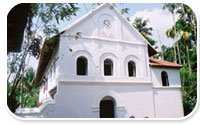 Chennamangalam Synagogue: Chennamangalam, situated 40kms north of Cochin near North Paravur, is home to a synagogue that is based on traditional Kerala architecture. The major attractions of this synagogue are the intricate artwork and the majestic altar. This 175 year old synagogue was recently renovated to its old glory. The oldes Hebrew inscription in India, dated 1269, can be found on a tombstone near the synagogue. Chennamangalam is also a village that splendidly displays religious tolerance with a church, synagogue, temple and mosque located close to each other. Chennamangalam Synagogue: Chennamangalam, situated 40kms north of Cochin near North Paravur, is home to a synagogue that is based on traditional Kerala architecture. The major attractions of this synagogue are the intricate artwork and the majestic altar. This 175 year old synagogue was recently renovated to its old glory. The oldes Hebrew inscription in India, dated 1269, can be found on a tombstone near the synagogue. Chennamangalam is also a village that splendidly displays religious tolerance with a church, synagogue, temple and mosque located close to each other.
St.Thomas Church: Christs apostle St Thomas is believed to have landed in Kodungalloor (formerly called Muziris) in 52 AD. The St.Thomas Church established by him houses ancient relics.The schematic map of the region around Kodungallur gives only a faint suggestion of the landscapes of the area, which is hardly above sea level and abounding in canals and lagoons and prone to flooding in the rainy season. It is now not possible to locate the ancient site of Musiris harbourat any of the present sites of the environs of Kodungallur.
Kodungalloor Bhagawati Temple: The Bhagawati temple at Kodungallur is of great renown throughout the state of Kerala. The Bharani festival at the Kodungallur Bhagawati temple is one of the grandest in Kerala
Cheraman mosque: The Cheraman Juma Masjid is believed to be the first mosque in India, built around 629 AD. The mosque is unique because it was baseed on traditional Hindu art and architecture and resembles a temple.
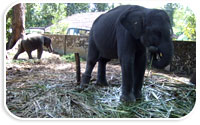 Kodanad: Kodanad lies on the southern bank of Periyar river amongst the scenic beauty of the High Ranges. It is 45 Kms. From Kochi city and 12 Kms. to the east of Perumbavoor town. There is an elephant training centre here. Facilities for elephant ride are provided here. There is also a mini zoo at Kodanadu. Kodanad: Kodanad lies on the southern bank of Periyar river amongst the scenic beauty of the High Ranges. It is 45 Kms. From Kochi city and 12 Kms. to the east of Perumbavoor town. There is an elephant training centre here. Facilities for elephant ride are provided here. There is also a mini zoo at Kodanadu.
Malayatoor: On the slopes of the picturesque Western Ghats, 52 Kms. From Kochi and 8 Kms. From Kalady is the Malayattoor Church. This is a Christian pilgrim centre and is believed to have been blessed by the Apostle of Christ, St. Thomas and the Church atop the hill was established in AD 900. Malayattoor is accessible by road up to the foot hills of Kurishumudy. The church at the top of the hill, about 2 Kms. can be reached only by foot. Situated beside the Periyar river and a small lake called Manappattuchira, Malayatoor is also a place of scenic beauty.
Kalady: Is the birth place of one of India's foremost philosopher's Adi Sankaracharya who preached advaita or monotheism. The temple also encloses the samadhi of Sankaracharya's mother Aryamba. The location on the bank of the river where the young Sankara was held by a crocodile can be seen nearby. The Ramakrishna Advaita ashrama adjoining the Sri Krishna temple nearby has a beautiful shrine modelled on the Sri Ramakrihna temple at Belur Math. The 8-storey Adi Sankara Keerthi Sthambam is a monument that tells Sankaracharya's story in paintings on the wall as one ascends the structure along a spiral staiway. The view from the top is breathtaking.Kaladi is 48 kms north-east of Cochin.
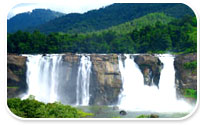 Athirapally: At the entrance to the Sholayar ranges, 78 kilometers from Cochin, this scintillating waterfall is a popular tourist spot.A picturesque spot adjacent to thick green forest land.Nearby the gliding Vazhachal waterfall is a part of the Chalakudy river.Affording to the onlookers, one of the most bewitching sights, Athirappally Falls is about 80 feet high and located in the forest area. Combined with the greenery, it infuses freshness into any tired soul. Athirapally: At the entrance to the Sholayar ranges, 78 kilometers from Cochin, this scintillating waterfall is a popular tourist spot.A picturesque spot adjacent to thick green forest land.Nearby the gliding Vazhachal waterfall is a part of the Chalakudy river.Affording to the onlookers, one of the most bewitching sights, Athirappally Falls is about 80 feet high and located in the forest area. Combined with the greenery, it infuses freshness into any tired soul.
The Athirapally Falls join the Chalakkudy River. The Vazhachal waterfall is a scenic and popular waterfall on the edge of the Sholayar forest range in Kerala
Guruvayoor: The Sree Krishna temple here is very famous attracting close to ten million pilgrims every year. This is regarded as the first Hindu temple to open its gates to all Hindus, irrespective of caste. Only Hindus are permitted to enter the temple.
The elephant sanctuary, the only one of its kind in the world, 3kms north of Guruvayoor is home to around 50 elephants. The sanctuary is at the Punnathur Kotta, which used to be the palace of the Punnathur rajas (kings).
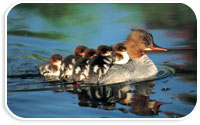 Thattekad Bird Sanctuary: Thattekad bird sanctuary is located 60kms east of Cochin near Kothamangalam. On the northern bank of river Periyar is a tropical evergreen forest in the foothills of the Wester Ghats. Spread over 25 sq kms, this bird sanctuary was once regarded as the richest bird habitat in peninsular India. In spite of recent developments and deforestation, this sanctuary is still home to a large number of rare and exotic bird species. It is also Known as also known as the Dr Salim Ali Bird Sanctuary. A trip through this sanctuary would certainly be a bonanza for any birder with its over 270 species in a relatively small area of 25 sq kms area. One should see the rare Mottled Wood Owl, Spot-bellied Eagle Owl, Malayan Night Heron, Sri Lanka Frogmouth, Rusty-tailed Flycatcher, Grey-headed Bulbul and the Nilgiri Wood Pigeon. Thattekad Bird Sanctuary: Thattekad bird sanctuary is located 60kms east of Cochin near Kothamangalam. On the northern bank of river Periyar is a tropical evergreen forest in the foothills of the Wester Ghats. Spread over 25 sq kms, this bird sanctuary was once regarded as the richest bird habitat in peninsular India. In spite of recent developments and deforestation, this sanctuary is still home to a large number of rare and exotic bird species. It is also Known as also known as the Dr Salim Ali Bird Sanctuary. A trip through this sanctuary would certainly be a bonanza for any birder with its over 270 species in a relatively small area of 25 sq kms area. One should see the rare Mottled Wood Owl, Spot-bellied Eagle Owl, Malayan Night Heron, Sri Lanka Frogmouth, Rusty-tailed Flycatcher, Grey-headed Bulbul and the Nilgiri Wood Pigeon.
Cheruthuruthy (Kerala Kalamandalam): Kerala Kalamandalam at Cheruthuruthy, was founded by Malayalam Poet Vallathol in 1930. Main objective was to revive, preserve and develop ancient and traditional art form of Kerala, particularly Kathakali.Kalamandalam has been the nursery of Kerala's renowned kathakali artistes. Hundreds of boys and girls are undergoing training in various branches of performing arts such as Mohiniyattom, Koodiyattom and Ottan Thullal. Many foreigners captivated by the language of Kathakali and other art forms are joining the training sessions. Koothambalam attached to the Kalamandalam is a major attraction. The Samadhi (tomb) of the founder-poet is in the premises of the Kalamandalam on the banks of River Bharathapuzha. Location: Shornur (Thirssur district) Near Shornur railway station on Mangalore- Chennai route. 29 Km away from Thrissur, bus services from Thrissur Private bus stand.
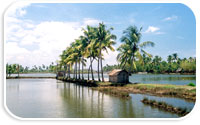 Alappuzha: The Venice of the East welcomes you to the backwaters of kerala.The Palm fringed canals and shores bustling with glimpses from the day to day life in the country side, the mirror still lagoons, picture book lakesides and its long sandy beach has blessed Alappuzha.Alappuzha is very famous for its boat races, houseboats, coir products, fish and lakes. Alappuzha is interlocked with a large number of canals and bridges.This water locked district has immense untapped potential for backwater tourism, preserved through the ages and completely hidden from the road is an enchanting experience to any visitor. Gliding along the calm and serene backwaters flanked by green leaves and palms seeing a rural more so while sailing a slow-moving, spacious Kettuvallam. Alappuzha: The Venice of the East welcomes you to the backwaters of kerala.The Palm fringed canals and shores bustling with glimpses from the day to day life in the country side, the mirror still lagoons, picture book lakesides and its long sandy beach has blessed Alappuzha.Alappuzha is very famous for its boat races, houseboats, coir products, fish and lakes. Alappuzha is interlocked with a large number of canals and bridges.This water locked district has immense untapped potential for backwater tourism, preserved through the ages and completely hidden from the road is an enchanting experience to any visitor. Gliding along the calm and serene backwaters flanked by green leaves and palms seeing a rural more so while sailing a slow-moving, spacious Kettuvallam.
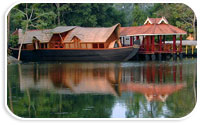 Kumarakom: The village of Kumarakom is a cluster of little islands on the Vembanad Lake. The lake, an enchanting picnic spot and a fast developing back water tourism destination, and its small water world is part of the Kuttanad region. Kumarakom: The village of Kumarakom is a cluster of little islands on the Vembanad Lake. The lake, an enchanting picnic spot and a fast developing back water tourism destination, and its small water world is part of the Kuttanad region.
A 14 acre bird sanctuary is situated on the eastern banks of the Vembanad Lake. The sanctuary adds to the natural beauty of Kumarakom. Birds (waterfowl, water ducks, cuckoos, wild ducks etc.) nest and spend happy summers here. Birds like Siberian Storks migrate here every year and is an ornithologist's paradise.
Munnar: Munnar is a beautiful hill station covered with unending expanse of tea plantation is 165 km away from cherai. 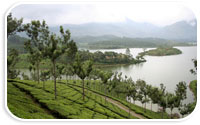 This was once the summer resort of the British Government in South India. A hill station transcending excellence – Munnar is surrounded by gently undulating hills swathed in the soothing green of vast tea estates makes it perfect tourist destination in south India. Situated at an altitude of 1600 m above sea level, its bracing climate with the laidback atmosphere and its delightfully refreshing colonial air makes it the most sought-after destinations This was once the summer resort of the British Government in South India. A hill station transcending excellence – Munnar is surrounded by gently undulating hills swathed in the soothing green of vast tea estates makes it perfect tourist destination in south India. Situated at an altitude of 1600 m above sea level, its bracing climate with the laidback atmosphere and its delightfully refreshing colonial air makes it the most sought-after destinations
Picture book towns, winding lanes, trekking and holiday facilities make Munnar a unique experience Munnar also has the highest peak in South India - Anamudi , which towers over 2695 m. Anamudi is an ideal spot for trekking.
Thekkady: The pride of Kerela and a testimony to nature's splendor and human innovation, the Periyar Wildlife Sanctuary is situated on the banks of the Periyar Lake .It is an artificial lake was created in 1895. Thekkady is 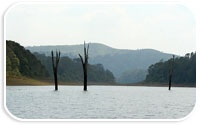 200 km away from cherai. The drive to Thekkady itself as enchanting as the road winds the high ranges. The Western Ghats are clothed in dense ever green, moist deciduous forests and savannah grass lands. Below this thick green canopy roam herds of Wild elephants, sambar deer, tigers, buffaloes, gaurs, lion tailed macaques and Nilgiri langurs. The sanctuary offers a lovely and comfortable way to see the animals via - boat rides on the man-made lake, which the wildlife areas encircle. 200 km away from cherai. The drive to Thekkady itself as enchanting as the road winds the high ranges. The Western Ghats are clothed in dense ever green, moist deciduous forests and savannah grass lands. Below this thick green canopy roam herds of Wild elephants, sambar deer, tigers, buffaloes, gaurs, lion tailed macaques and Nilgiri langurs. The sanctuary offers a lovely and comfortable way to see the animals via - boat rides on the man-made lake, which the wildlife areas encircle.
A tourist can get a great opportunity for treks mountain walk, Bamboo rafting and Jungle patrol.Thekkady is also a spice trading centre. Cardamom, pepper, vanilla, clove, cinnamon, nutmeg and ayurvedic herbs are planted here. |
